Comalapa Naïve
written by Dianne Carafino
“The Florence of Guatemala” was once posted on a sign at the entrance of San Juan Comalapa. Regardless of such a welcome, Comalapa —an easy hour or so drive from La Antigua Guatemala—could hardly look less like Florence, Italy. Nestled among pine trees and cornfields in the scenic mountainous Western Highlands of the Department of Chimaltenango, Comalapa presents a sleepy appearance on a non-market day. As one comes into the town, however, the first hint of a unique heritage presents itself. Along both sides of the road, murals depicting the town’s history are painted on walls fronting the street. The murals begin with representations of the Maya ancestors of the Kaqchikel community, through various phases of the area’s history, to the present day.
Along the way to the center of town are the homes of a number of well-known artistic families. Usually the front rooms of the homes double as galleries, and, with any luck, a visitor will be greeted by the artist himself or a close relative. Conversations with the artists are equally as engaging as viewing their work. The art of Comalapa is known for its naïve paintings, which feature native dress, focusing on the long, colorfully striped shawls with tasseled ends worn by the women, and the indigenous customs of the area.
Perhaps best known of the artists from Comalapa is Andrés Curruchiche, the first Kaqchikel Maya oil painter and, many feel, the most important naïve painter of Comalapa. The Ixchel Textile Museum in Guatemala City displays a permanent exhibit of his work, which demonstrates the dress of Comalapa residents beginning in the 1920s. Curruchiche’s home, at 0 Avenida 3-76, is open to visitors, and his granddaughter, María Elena Curruchiche, herself an accomplished artist, is a delightful historian of the careers of her grandfather and father, Vicente Curruchiche, also an acclaimed artist.
María Curruchiche has one of her own paintings, Navidad, delightfully demonstrating the Christmas customs and dress of Comalapa, featured as the December painting of the Arte Maya 2009 calendar. The calendar may be purchased at the family home and in many shops featuring Guatemalan artisans. A visit to the Curruchiche home should definitely include a visit to the upstairs gallery, which includes textiles woven by Doña Isabel Vda. de Curruchiche, María Elena’s mother, which are for sale. Textiles include huipiles, or traditional blouses, woven with the naturally brown cotton of Guatemala.
Down the street and around the corner is the home and gallery of Oscar Perén, perhaps best known for his humorous painting of the interior of a “chicken bus,” which has become a well-known poster. Even a casual conversation with Oscar demonstrates his abilities as a story teller, verbally as well as in his artistic work. Pulling out a photo album of previous paintings, he points to one. “This is me when I was 12 years old,” he says of a painting of a barefoot boy peeking in a doorway of a room where Andres Curruchiche is painting. “I saw Sr. Curruchiche painting when I was 12 years old, and I knew I could do that, too. I’m barefoot in the painting because I didn’t have a pair of shoes until I was 15, and I didn’t sell my first painting until I was 20, but on this day I knew I could do it. I was so excited when I realized that, I didn’t hear a thing the teacher said that day.”
“This is Comalapa the day before the (1976) earthquake,” Sr. Perén comments, as he continues to show his visitors around his gallery. “Everything is in order. This is Comalapa the next day,” he says of the following painting. On around the gallery goes the explanation, illuminating even further the story that each painting tells.
Back along the main street of town, the visitor has only to ask to be directed to the gallery of Feliciano Bal and his family. Sr. Bal himself answers the door and graciously shows the visitor around the gallery, the two front rooms of his home. The elder Sr. Bal has for many years painted the changing landscape of Comalapa and its inhabitants, from the time when the main street coming into town was a dirt road.
Also in the Bal family gallery are works by Walter Bal, following very much in the family landscape tradition and Omar Bal.
Omar Bal’s paintings are easily recognized as focusing on the traditional dress and market activities of Comalapa’s residents, but in a more stylized, modern approach. His paintings are perhaps well known to the visitor of artisan markets as the “no- face” paintings, groupings of market vendors in stylized renditions of traditional costumes, with their faces painted out.
On the way back out of town, a serendipitous stop almost on the edge of town leads to the gallery of two of Oscar Perén’s sons. The brothers Perén, Edgar and Orlando, each have slightly different approaches to the depiction of the customs of the people of Comalapa. Edgar’s paintings are of the traditional naïve style, and he demonstrates his father’s gift for storytelling as he explains the stories depicted in his “Maximoto Ceremony” painting. Orlando’s paintings sometimes have a more modern appearance. If you stop, don’t miss the small painted boxes here or the standing churches, which open into scenes of village life.
Although the visit to Comalapa’s artists was over for the day, other galleries wait to be explored at a later time.
photos: George Carafino
- Oscar Perén with some of his paintings in his gallery
- Murals cover the walls on the way in to Comalapa
- Murals cover the walls on the way in to Comalapa
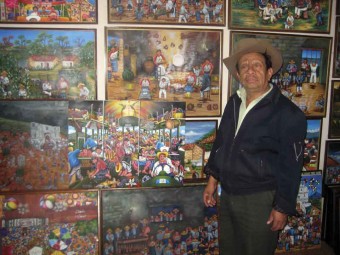
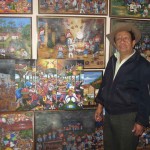
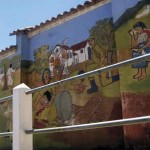
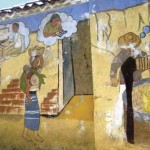
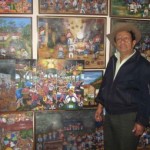
Hello Dianne, Thank you for your information on the family details of the local painters. I am looking into doing a community project to restore some of the destroyed parts of the murals, and will spend my winter vacation there trying to navigate and meet the directors and students painters responsible for the murals. Please let me know if you have any more information about the community of painters there. For example, do you know if there is anything published on the murals, other than an article by Mayanist ethnographer and friend, Walter Little?
My spouse runs a medical clinic in Santiago, Suchitapequez. Might you know if there are any painters set up there?